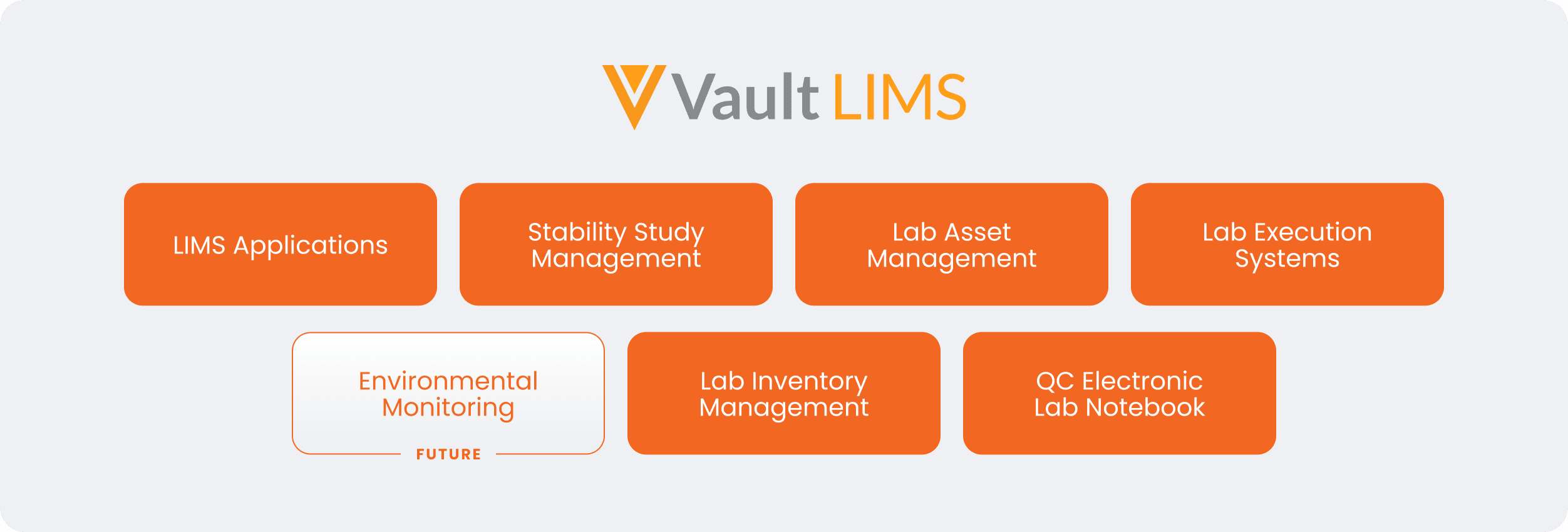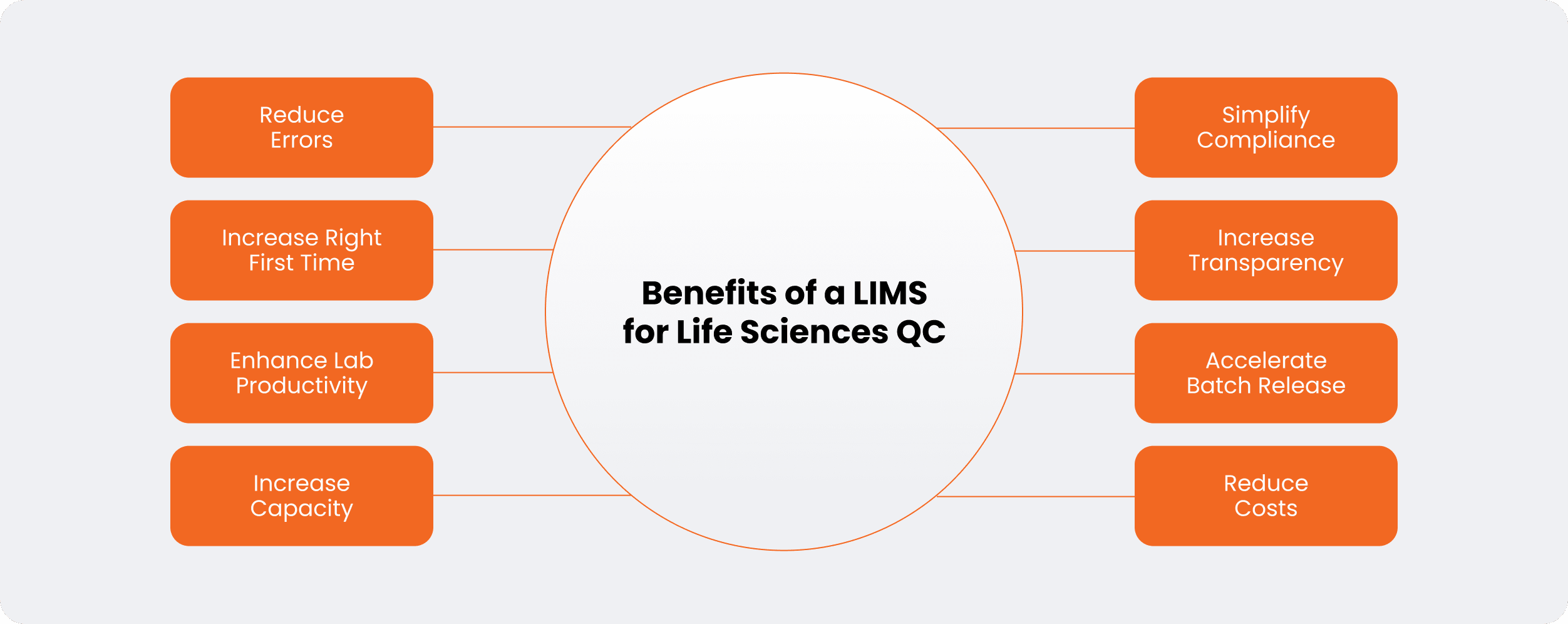A Laboratory Information Management System (LIMS) is a software solution designed to streamline laboratory operations, enhance data management, and promote compliance. Traditionally LIMS functionality covers several core areas: sample and program management, lab management and prioritization, test execution, data review, and reporting.
Veeva LIMS, however, redefines what a LIMS for life sciences is by including all the capabilities traditionally spread across multiple QC applications, including lab execution systems (LES), inventory and asset management systems, environmental monitoring (EM) tools, QC electronic lab notebooks (ELN), scientific data management systems (SDMS), and much, much more.
No — a LIMS is much more than just a database. A LIMS is a comprehensive software system that includes database functionality along with additional value-adding features such as workflow management, real-time data capture, instrument integration, data analysis tools, and reporting capabilities.
Veeva LIMS in particular also has built in functionality that is typically delivered by a host of fragmented software applications, including:
- Lab execution systems (LES)
- Inventory and asset management systems
- Environmental monitoring (EM) tools
- QC electronic lab notebooks (ELN)
- Scientific data management systems (SDMS)
- Stability data management tools
- Sample management systems
- Cleaning sample management and tracking systems
- Lab investigation management tools
- Lab automation systems
A LIMS can store a wide range of QC laboratory data. Only the most advanced systems built specifically for pharmaceutical QC processes can securely and efficiently store and manage:
- Master data (such as methods, calculations, sampling plans)
- Sample information (such as type, origin, receipt date)
- QC test data
- Stability study data
- Instrument calibration and maintenance records
- Inventory management data
- Audit trails
Traditional LIMS typically support several core functions: sample and program management, lab management and prioritization, test execution, data review, and reporting.
However, Veeva is redefining LIMS, with VaultVeeva LIMS offering functionality beyond a legacy LIMS. Veeva LIMS incorporates functionality to help manage your entire end-to-end QC processes, without needing to rely on multiple disconnected software systems.
With an advanced QC-focused LIMS, companies can eliminate paper-based processes, reduce errors, simplify and streamline workflows, promote compliance, foster collaboration, and speed batch release. In the most advanced solutions, such as Veeva LIMS, companies can also unify their entire QA and QC operations under a single platform.
ERP (Enterprise Resource Planning) systems are broader, company-wide solutions that help support and automate various business processes and functions such as accounting, procurement, human resources, and supply chain management. A LIMS focuses specifically on QC laboratory operations, such as sample management, data management, and lab workflow automation. While ERP systems may have laboratory modules, they typically lack the depth and specificity of a dedicated LIMS in handling complex laboratory data and workflows.
LIMS, LES (Laboratory Execution Systems), and ELN (Electronic Laboratory Notebooks) have typically been seen as distinct, but complementary, laboratory software solutions. LIMS have traditionally focused on sample management, workflow automation, and lab data management, whereas LES guide analysts through specific testing procedures in compliance with SOPs. ELN systems simply replace paper notebooks for documenting experiments, observations, and unstructured data.
Advanced platforms such as Veeva LIMS, however, incorporate the functionality of LES and ELN systems (as well as a host of other capabilities) into the LIMS, consolidating systems for simplified processes and improved user experience.
Yes. A QC-focused LIMS can help virtual organizations manage externally generated QC data, saving hundreds of hours typically spent on consolidating, analyzing, and reporting.
Working from a single source of quality data improves efficiency by making it easier to identify exceptions and mistakes quickly. These capabilities help virtual organizations meet their responsibilities when outsourcing and improved audit and inspection readiness.
Yes. Modern LIMS have been designed with a range of robust security features to protect sensitive and valuable life sciences QC data. These features include user authentication, role-based access, e-signatures, audit trails, and data encryption at rest and in transit. Modern LIMS will also receive regular security updates and patches to ensure vulnerabilities are fixed and systems are protected against the latest threats. That said, a critical part of maintaining the security of data in a LIMS is proper implementation, configuration, and regular security audits and comprehensive employee training.
Advanced GMP QC-focused LIMS can support compliance in several ways. For example, the most advanced LIMS:
- Maintain meticulous audit trails
- Strictly control user access with role-based access
- Display effective test method procedures
- Implement electronic signatures in line with 21 CFR Part 11 requirements
- Ensure easy data retrieval and review for inspections and audits
- Verify user qualifications, ensuring only qualified personnel perform tests
- Automatically generate compliant reports and certificates of analysis (CoA)
- Initiate lab investigations following out of specification results
- Display relevant quality events during reviews
LIMS Implementation
Implementing a LIMS is a multistep process that requires careful consideration and cross-functional team collaboration. Key components of a logical implementation plan include the following:
- Understanding your QC organization’s goals
- Gathering end user requirements and selecting the right LIMS
- Project planning and team formation
- System configuration and customization
- Data migration from existing systems
- Integrating the LIMS with equipment, instruments and other software
- Testing and validation
- Training laboratory staff and administrators
- Developing Standard Operating Procedures (SOP)
- Go-live execution
- Post-implementation support and optimization
However, each individual implementation will be different. A thorough scoping exercise is therefore needed to determine the best approach to achieve program goals and objectives. Seeking the advice and support of a trusted solution-provider who knows the unique complexities of GMP QC processes and has experience of complex software implementations can help streamline the process and reduce risks.
While a LIMS is necessary as a company prepares for commercial launch, implementing a LIMS even earlier during the clinical stage offers tangible benefits. A LIMS streamlines operations for clinical batch release and product stability, making it easier to scale up as the number of products, trials, release markets, and manufactured batches grows. As development progresses, a LIMS can also facilitate automation of labor-intensive tasks, such as generation of reports and regulatory submission content assembly.
Once a regulatory submission is made, it’s common to expect a regulatory inspection. A LIMS is a core component of the six principal quality systems used to demonstrate GMP controls. Adopting LIMS early helps with the enforcement of controls that can improve your inspection readiness and increase confidence of inspection performance.
In short, by implementing a LIMS early, ahead of commercialization, you can streamline essential business processes, leverage automation for better data insights and regulatory reporting, and create a foundation on which to scale your organization for market launch.
Veeva LIMS
A cloud LIMS has numerous benefits for QC organizations. Cloud LIMS have lower upfront costs relative to on-premise alternatives, are quicker to deploy, can more easily scale with the business, and receive regular and automated pre-validated updates, minimizing burden on in-house IT teams. (While purely externally hosted LIMS offer some of these benefits, end users will still typically need to manage some aspects of software security, maintenance, and updates.)
Veeva LIMS also features an admin interface that enables no-code configurations, making it easy to flexibly adapt to changing business needs. And, as a true cloud LIMS, Veeva LIMS keeps all clients on the latest software version, meaning customers can focus on innovating rather than maintaining multiple legacy systems.
For regulated customers of Veeva Software Solutions, the FDA regulations such as 21 CFR 211 Current Good Manufacturing Practice (cGMP) for Finished Pharmaceuticals and/or FDA Quality System Regulations (QSR) 21 CFR 820 have applicable sections that are relevant to processes where Computerized Information systems are utilized. In addition, the applicability of international standards may include the ICH Q9 (specifying management of risk), ICH Q10 (specifying the quality system), or ICH E6 (specifying management of the quality system), or ICH E6 (specifying clinical conduct). With respect to the application of Electronic Signatures to Electronic Records, 21 CFR Part 11 is applied in the US. In European markets, EudraLex Volume 4 Annex 11 requirements are relevant.
Veeva has adopted GxP-compliant practices while validating functions that have GxP applicability in one or more of the international markets. Areas of GxP applicability are identified by Veeva for typical application intended use. However, each customer must define the areas of GxP applicability and configure the product to comply with their intended use, including any business processes that the customer requires the system to meet. As the regulated user, the customer is responsible for the configuration and system operation, including user provisioning. As the Data Controller, the customer is responsible for the integrity of the resident data.
Veeva LIMS maintains comprehensive audit trails that comply with 21 CFR Part 11 and EU GMP Annex 11 requirements. All document and system activity, including actions around documents, logins, and configuration changes, is tracked and recorded in easy-to-access audit trails. Document actions that are audited include file operations, metadata changes (including the ‘before’ and ‘after’ values), and permission changes. System access actions include both successful and unsuccessful logins, as well as password resets and security policy changes. Configuration changes include any updates to document types, lifecycles, workflows and all business rules in the system. All data in the audit trail is available to Veeva LIMS’s time-based reporting, providing valuable insights into process opportunities for improvement. Veeva LIMS’s audit trail is immutable.
Veeva LIMS differs from other LIMS in that it redefines what a LIMS is: Veeva LIMS goes beyond the functionality of a traditional LIMS to include all the capabilities typically spread across multiple QC applications, such as laboratory execution systems (LES), electronic lab notebooks (ELN) — all in a single platform.
Unlike other LIMS, Veeva LIMS is built specifically for pharma GMP QC, and by an organization that focuses exclusively on the life sciences, meaning you can trust Veeva LIMS to deliver the functionality you need from day one — without expensive customizations. While many LIMS are offered via a subscription hosted model, Veeva LIMS is one of the only true cloud LIMS, offering customers flexibility and reducing the software maintenance and update burden on in-house teams.
Finally, Veeva LIMS is part of a unique unified quality solution — the Vault Quality Platform — which brings together applications, processes, and partners across content management, training, Quality Management System (QMS) and QC lab solutions. With the Vault Quality Platform, pharma companies can unify their QA and QC processes to promote compliance, drive efficiency, and foster collaboration, ultimately helping to accelerate the development and manufacture of high-quality medicines.
Veeva LIMS can be easily integrated with a range of systems and instruments. Veeva LIMS features standard interfaces to BarTender for label generation, as well as to Scitara and TetraScience platforms for integration with instruments and software, including Empower Software Solutions, and Zifo to simplify master data configuration during implementation. Customers can also develop enterprise interfaces to systems such as an ERP software using our public APIs.
Veeva helps support customers’ validation process in several ways. For example, we conduct instrument qualification (IQ) and operational qualification (OQ) so customers don’t have to. Veeva also offers optional validation accelerators to assist with establishing a validated status for their Veeva LIMS deployment. This includes a package of performance qualification (PQ)/user acceptance testing (UAT) documentation and script authoring services, as well as the option to staff a Validation Lead to support modification of Veeva’s standard Validation Package to meet customer configuration requirements.



